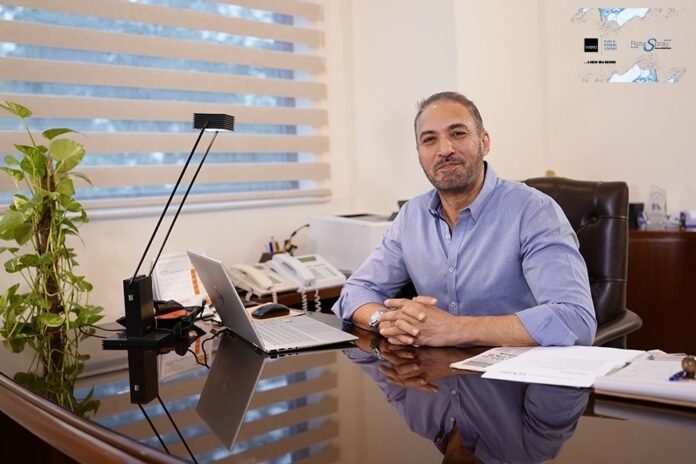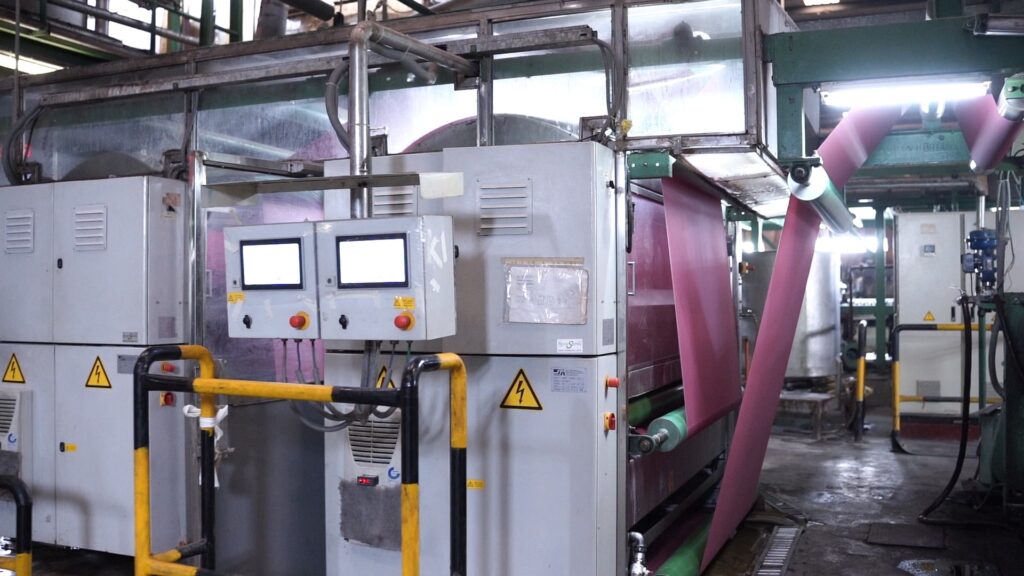Since 1953, WEKO has been developing and producing non-contact application systems for textile product optimization and surface finishing with different fluids and powdery substances. Weko Holding GmbH has taken over RotaSpray GmbH in January 2021 to further expand its textile segment.
Weko’s focus has always been on the lowest possible, exact, and replicable use of the respective resources, enabling customers to perform industrial production in a more environmentally friendly manner. The application areas are the nonwoven, paper, tissue, printing, wood fiber boards, foils, metal, and textile industries. Among these industries, worldwide textile production suffers from immense cost pressure and is driven by high volumes of fresh water, energy, and chemicals with comparatively slow production speeds. An estimated 100–150L of water is needed to process 1 kg of cotton textile. Furthermore, a high amount of toxic effluent generation from textile factories is another important concern that needs to be addressed properly. Therefore, WEKO and RotaSpray present the latest technology to promote sustainable textile manufacturing with cost and significant resource-saving potential.
The non-contact systems are running at different locations globally to serve different sectors, including textile dyeing and finishing. In 2019, Nishat Dyeing and Finishing (NDF) Lahore Pakistn, installed the world’s first RotaSpray continuous fabric dyeing system. TEXtalks International interviewed the focal person Adil Ghani, Technical Director NDF, to learn and explore more about the RotaSpray system, its advantages, and its potential.
TEXtalks:Can you share the history and work of Nishat Dyeing and Finishing?
Adil Ghani: Established in 2002, Nishat dyeing and finishing is part of Nishat Mills Limited. NDF is one of the most sophisticated dyeing units globally, with state-of-the-art systems. The Nishat group was established in 1951 and is one of Pakistan’s most modern and largest vertically integrated textile companies. The Nishat Mills Limited is engaged in the business of textile manufacturing, including spinning, combing, weaving, bleaching, dyeing, printing, stitching, apparel, buying, selling, and otherwise dealing in yarn, linen, cloth, and other goods and fabrics made from raw cotton, synthetic fiber, and cloth and to generate, accumulate, distribute, supply and sell electricity.
TEXtalks:What is RotaSpray dyeing, and why did NDF choose this?
Adil Ghani: As NDF truly believes in sustainable production, NDF chose the RotaSpray for the best possible benefits of innovative technology. Sustainable practices in the textile industry include using fewer amounts of water, hazardous chemicals, adopting eco-friendly production processes; using less energy for production processes; and introducing the 3 Rs – Reduce, Reuse, and Recycle. Thus, RotaSpray reduces the resource consumption for NDF.
Proudly, NDF is the first industry globally who choose RotaSpray for bulk production of woven fabrics. RotaSpray is a Patented Spray Dyeing for Yarn and Fabric. The non-contact spray application also allows the defined application of high-affinity optical brighteners, fixing agents, functional chemicals, special neutralization agents, dyes, and oxidation chemicals. Significant water, chemical, and energy savings can be achieved by optimizing the spraying parameters in the RotoDyer and RotoCoater spraying technology in finishing textile fabrics and warp yarn dyeing. The newly developed PS2 Pad-Spray-Steam Process for yarn and fabric enables salt-free continuous dyeing of Reactive dyes without limitation of color depth. The diffusion behavior of the dyes is comparable with the Cold Pad Batch dyed material and continuous pad-dry-pad-steam process. Using the RotaSpray System, the intermediate drying is eliminated, as normally used in the classical pad-dry-chemical or pad-steam process. This leads to significant energy savings and much lower investment costs.
TEXtalks:What is the main difference between RotaSpray and the conventional system?
Adil Ghani:: The RotaSpray by Weko is completely different and innovative compared to the conventional dyeing systems. In conventional reactive dyeing, the process requires enormous amounts of salt to facilitate dye exhaustion and absorption ranging from 40 to 100 g/l.The treatment of colored salt effluent is one of the scorching issues in the textile processing house as it significantly increases the carbon footprints along with the cost of dyed goods. However, the RotaSpray eliminates salt utilization without compromising shade depth to make it more sustainable. Because of the spray technology, RotaSpray reduces water and energy consumption. A pad-thermosol normally takes about 60-70 kWh of energy, while RotaSpray takes only 05kWh of energy consumption. This is to indicate one of the advantages of this machine.
TEXtalks:What are the key advantages of the RotaSpray Systems you would like to share with the industry?
Adil Ghani: It has been three years since we have been using the system. It works 24 by 7 and has less downtime and easy maintenance. The results are excellent, with an additional saving of 30-35% in energy consumption, chemical consumption, and reduced carbon footprint.RotaSpray avoids the conventional dyeing route, enabling industries to save big, and the short process means fewer production times. The RotaSpray can easily do reactive and vat continuous dyeing that is beyond the reach of conventional dyeing processes. For example, the cold pad-batch method can be applied for reactive dyeing, but the cold pad-batch process is not possible for vat dyes. However, with RotaSpray, customers can do reactive and vat dyeing without compromising performance. The process has serval advantages, including fast processing and reduced energy, water, and auxiliaries consumption. Furthermore, RotaSpray systems can be used for light to medium shade without problems and with excellent reproducibility.
TEXtalks:How do you rate the innovative RotaSpray Dyeing System?
Adil Ghani: RotaSpray dyeing system is a revolution in continuous dyeing.It reduces resource consumption, as mentioned already, and produces reproducible results, which is of the utmost importance for a dyeing house. In today’s processes, huge liters of dyeing and washing bath volumes are typical. Also, permanently re-feeding fresh dyestuffs, chemicals, auxiliaries, or water are needed during processing to keep quality results stable from start to stop. Draining all the dye bathes, especially sulfur and reactive, results in high water treatment volumes and costs after each production lot and wastes our natural resources of fresh water. However, with Weko RotaSpray’s technology, all the limitations are no more, making this technology the future of sustainable dyeing.
TEXtalks:How does the RotaSpray reduce the need for space and yet provide cost-effective production?
Adil Ghani: The RotaSpray eliminates the need for a process, reducing machine cost (capital investment), shorter process, and saving energy. The RotaSpray is only 30% of the capital investment than the conventional setup and requires almost no maintenance. Thus, the RotaSpray requires less space for installation and operation.The dyeing results are similar to the conventional process, even without auxiliaries (salt), so the RotaSpray is more economical and feasible.For us even with the Pandemic situation, I think the payback period is almost four years regarding the investment.
TEXtalks:For which application is NDF using the RotaSpray Technology?
Adil Ghani: Using RotaSpray Technology, NDF is doing reactive and vat dyeing. Initially, the system was developed for vat dyes, and NDF took the risk of installing the world’s first machine for reactive dyeing. We have produced satisfying results without limiting shade dept even without salt. The fabric first passes through the padding system, then the spraying system and steaming. After steaming, the fabric is washed to remove the unfixed dyestuff. NDF is using it with complete trust and excellent results.
TEXtalks:How has Nishat reduced its carbon footprint by choosing Weko’s technology?
Adil Ghani: Reducing carbon footprint is important because it mitigates the effects of global climate change, improves public health, boosts the global economy, and maintains biodiversity. When we cut carbon emissions, we help ensure cleaner air, water, and food for our future generations. By using RotaSpray, we reduced our carbon footprint as it saved 1,331 tons of CO2 emissions annually. This also highlights the mission of NDF to adapt to sustainable technology to save our motherland. Thus, Weko’s RotaSpray technology is one of the most required innovations at the right time for the textile dyeing houses.




